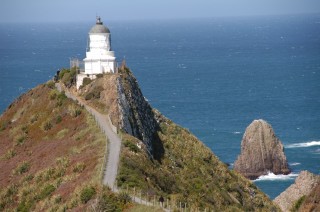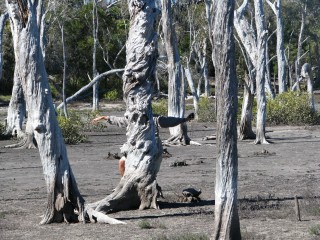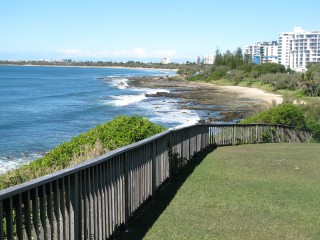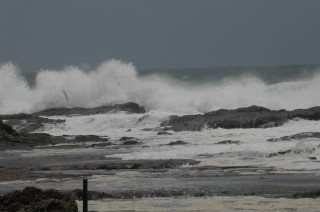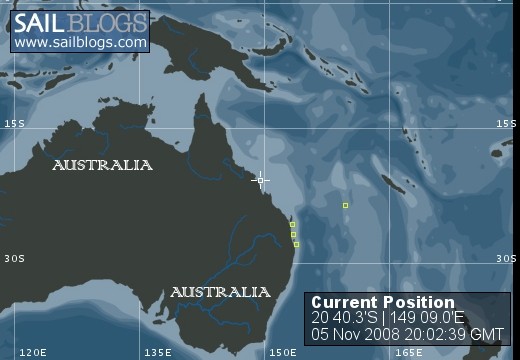
Silkie's Journal
05 November 2008
07 September 2008
02 August 2008 | Queensland, AU
17 May 2008 | Lat 27 48'S; Long 153 26'E
26 October 2007 | Lat 23 24'S Long 159 19'E
01 September 2007 | Lat 13 17'S Long 163 54'W
01 July 2007 | Lat 17 34'S Long 149 37'W
11 May 2007 | Lat 0 45'S Long 90 18'W
13 April 2007 | Lat 08 56'N, Long 79 33'W
24 March 2007 | Lat 09 19'N, Long 80 00'W
11 February 2007 | Lat 15 50'N, Long 88 44' W
On the Water Between New Caledonia and Bundaberg, AU
26 October 2007 | Lat 23 24'S Long 159 19'E
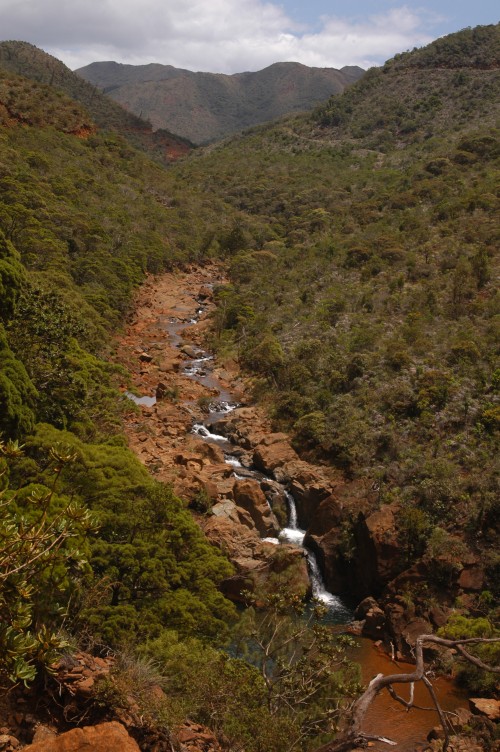
Our trip to Pago Pago (pronounced pahn-go pahn-go), American Samoa, from Suwarrow Atoll took us three days during which time we saw some of the largest seas so far, but no problem. They were long period swells coming on our port stern quarter. Silkie just rose up with them and they moved on by, really neat to watch (and feel). American Samoa (the natives pronounce it Sam-oa, accent on Sam) is a very beautiful island and the people are very friendly. It is an insular possession of the US, its people are US nationals (not citizens) and have unrestricted entry into the US. We spent our time there in the company of Asylum, Fifth Season and Rasa Manis, and shared a rental car with two of them (the people that is). We toured most of the island by car and were very impressed with its natural beauty. The great bulk of the island is owned communally by the various villages and very little is owned in fee simple by individuals although apparently outsiders can lease property from the villages for periods of time.
Pago Pago is the main town and the place cruisers love to hate, mostly because of the harbor. The older cruising guides often have nothing nice to say about it. They are right and they are wrong. The harbor is fairly large and the small boat anchorage is at the end after a sharp left turn so that it is well protected from the ocean swell. It is not, however, protected from the strong winds that come howling down the steep mountain sides that surround the harbor. In addition, the holding is not very good and that makes for uneasy anchoring. The largest residents of the harbor are two tuna processing plants. They have been there for a long time and for years abused the harbor terribly by dumping fish remains into the harbor. As of about 1991 and since, they have cleaned up their act by installing a pipe that dumps some effluent outside the bay and by moving by barge more solid waste into deep water several miles outside the harbor. Still the harbor is dominated by a periodic strong drying fish smell and the anchorage appears to have streaks of brown/blood red water, alternating with dark green and lighter green patches. Very very weird.
Ashore, the town has the cruiser friendly Pago Pago Yacht.Club. which appears to be mainly a drinking establishment, a very nice and reasonably priced restaurant, several 24 hr laundries which cost $1/large load to wash, 75 cents/30 minutes to dry, and an internet caf� which serves a cheap American-style breakfast. . Most people speak English, money is US dollars, car rental is very reasonable and a Cost-U-Less is just 30 minutes by car. This store carries a lot of American brands, what a joy! This is really a great place to re-provision.
While we were there we checked out the slipway across the water from the anchorage. All info about Pago Pago will tell you that there are no repair facilities for small boats (read "most cruisers") there. As of 41 days prior to our visit, that was true. The slipway, renamed MYD Samoa, is now owned by an American who is interested in developing a relationship with cruisers for small boat storage and repair. We saw the whole yard, complete with crane, a 3,000 ton capacity slipway which can handle 2 boats at a time, numerous large metal working machines dating back to WWII and a milling machine which can thread a very large propeller shaft. Very impressive. Also very impressive was the amount of rust on the slipway beds and on the large chains that move them in and out of the water. Owner Bob Weihe says the outer rust protects the inner metal. I hope he's right. In any case, we sent the info we got from Owner Bob to our friends on Bella Donna, a 76 ft Catamaran, 100,000 lbs. displacement, who needed a haulout to replace a prop. They were hauled in the afternoon and put back in the next morning, repair complete. Happy ending.
We had dinner one Wednesday night at the Barefoot Bar and Restaurant located about 7 mils out of town. This is owned and run by the daughter of a local chief with the assistance of Candy Man. Candy Man is a Kiwi, has been in Samoa 17 years, has gone native to the extent of becoming tattooed from navel to knees in the traditional Samoan style. (The magnificent tattoo signifies his right to serve the Chief). On Wednesdays they serve a traditional Samoa feast where all the food is cooked in a "umu" as follows: dig a hole in the ground, fill it with wood, cover the wood with many 3-4 inch diameter stones, light the wood, get the stones very hot, place the meat, vegetables and other dishes on the stones and cover all with layers of banana leaves, let cook for about 3 hours, serve on banana leaves and eat with your fingers. Very good. There were about 30 guests at the feast. John, David, Jim and Tom all wore lavalavas (a.k.a., skirts, or perhaps kilts), the traditional Samoan male outfit, with bright shirts and necklaces while we gals wore brightly patterned sarongs.
Our last item of business in Pago Pago was to pick up our new crew from the airport. Garrett Shook (John Shook's nephew) is a young fellow just out of the Navy (10 years) who wants to see the world from some place other then an F16. He will be with us until Australia. He's been great to have aboard and we will be sorry to see him go off to see more of the rest of the world.
Niautoputapu. From Samoa we sailed overnight to the most northern of the Tongan chain of islands, Niautoputapu, which means Very Sacred Coconut (but is otherwise known to us illiterate cruisers as "New Potatoes".) The anchorage there is large with good holding, the people very friendly and welcoming. We met the chief of the island and attended a cookout with small pigs roasted over an open fire. The locals here supplement their income by arranging cookouts, feasts, dances, tours etc., charging a very reasonable fee. All in all, between events on shore and socializing among the four cruising buddy-boats (Asylum, Priscilla, Fifth Season and Rasa Manis) a very good time was had by all.
Savusavu. At New Potatoes we parted company with the boats that we had traveled with since French Polynesia. They are all going to New Zealand for the storm season via southern Tonga while we decided to bypass NZ and sail to Australia via Fiji and New Caledonia. (Don't worry; we will see NZ by air and car.) So from New Potatoes we set a course for Savusavu, Fiji, a three day run.
Up to this point, we had seen very little rain, anywhere on our trip through the South Pacific, just warm sunny days and cool nights. In Savusavu and throughout the rest of Fiji we saw nothing but rain. The harbor at Savusavu was small and the water not of a quality that you wanted to run the water maker. No problem. We hooked hoses to the coach roof drains and filled our water cans full to overflowing every night. The town is very similar to other small towns we've been in; a myriad of small stores that carry all the same stuff but with small variations so that you really have to shop them all to find the sewing needles or the particular hardware you need; the fresh produce market; the souvenir shops, the bus station, etc. We stayed there longer then we would have wished due to high winds and rough seas, both in the wrong direction, but it was no great hardship given the beauty of the water and land and the pleasant atmosphere at the Copra Shed Marina. After eight days on a mooring, wind and seas calmed enough that we could leave Savusavu and motor south to Makongai Island. We spent a quiet (and dry) night there in a beautiful harbor almost completely surrounded by island with a small community of 7-8 houses on shore. This was one quiet, peaceful place. I guess that's why they located the leper colony there. Our next stop was Levuka, on Ovalau Island, the old colonial capital of Fiji. From the boat we could see a narrow strip of town along the shore and a commercial district but very few houses. Where did all the people live? We went for a walk and took a side street that went up the mountain behind the main part of town and found many small houses, hidden from the shore by the lush greenery, located amongst the rocks and streams of the mountain side and connected by a complex spider-wed of narrow poured-concrete walkways with many steps going up and down. These walkways were quite steep in parts and curved in, out and around the numerous large mountain boulders. There was no way any motorized vehicle could negotiate these walks. So how that 40 HP outboard engine got almost to the top-most dwelling is beyond me. Must have been pure unadulterated man-power that did it. Having by now a good idea of how much groceries weigh, I wondered how the old grannies got their groceries up to their houses.
Suva, Fiji. Our last stop in Fiji was at Suva, the capital, where we would check in and out (having already checked in and then out at Savusavu and again at Levuka). As we were coming in the pass we saw the hull of a sailboat that had gone on the reef two days earlier as it tried to enter at night during bad weather. The next day we saw the hull (missing its keel which had been sawed off) being towed off the reef on its side. What a sad sight. We understand that the people got off safely. Suva is a large, dirty, crowded city. We spent two nights anchored in the large harbor, lots of anchor room in shallow water, but at this point we were ready to move on and not interested in a large dirty city.
Noumea, New Caledonia. We left Suva on October 6 and arrived in New Cal on the 10th. In the interim we got the first clear indication that the stbd sail drive was failing when we could not get it into gear. Not good. We were not totally unprepared for this as we had been warned about it recently by another cat cruiser with the same Yanmar SD40 saildrives (Thank you Madame). We also experienced a complete failure of our two separate chartplotters and a separate Furuno GPS to give us speed over ground or lat/long position. This condition lasted about thirty minutes and then self-corrected, i.e. all systems started working again by themselves it seemed. During this time, our old Garmin 76 handheld GPS worked fine. Our guy at Furuno tech support suggested that the problem may have been with the WAAS satellite system. In any case, we were back in business soon enough and have had no further trouble with that.
Noumea is the only city in New Caledonia. It is a very nice place, VERY FRENCH, with baguettes, bakeries, pastries, fine restaurants, parks, museums, internet, and three large first class marinas with lots of blue water boats. In short, it's a small Papeete, only better. We took a slip at Port Moselle Marina, right in the center of town with the morning fresh produce market within a 4 minute walk of our boat (open 5:30 to 11:30 AM, 7 days a week). The slip cost us about $45/day with water, no electricity (thank you solar panels), and great warm water showers. This was the first time we had been in a slip since Shelter Bay, Colon, Panama back in April. Priscilla met up with us there and we spent a lot of time with Tom and Suzie including renting a car and driving around the southern half of the island. There ain't much out there folks except beautiful countryside quite empty of people. We stayed 14 days at Noumea, several of those waiting for a low to pass by and the seas to calm, at which time we left for Bundaberg Australia with 17 other boats in the Port 2 Port Rally. As I write this we have about 360 nm to go and expect to arrive in Bundaberg (famous for their rum) in two+ days or so. So far a very nice run. Bundaberg will mark the end of this leg of the journey and quite a leg it has been: many beautiful places and experiences in 11 months and over 11,000 sea miles since Oriental, North Carolina.
'Till next time.
Susan and John on S/V Silkie
Pago Pago is the main town and the place cruisers love to hate, mostly because of the harbor. The older cruising guides often have nothing nice to say about it. They are right and they are wrong. The harbor is fairly large and the small boat anchorage is at the end after a sharp left turn so that it is well protected from the ocean swell. It is not, however, protected from the strong winds that come howling down the steep mountain sides that surround the harbor. In addition, the holding is not very good and that makes for uneasy anchoring. The largest residents of the harbor are two tuna processing plants. They have been there for a long time and for years abused the harbor terribly by dumping fish remains into the harbor. As of about 1991 and since, they have cleaned up their act by installing a pipe that dumps some effluent outside the bay and by moving by barge more solid waste into deep water several miles outside the harbor. Still the harbor is dominated by a periodic strong drying fish smell and the anchorage appears to have streaks of brown/blood red water, alternating with dark green and lighter green patches. Very very weird.
Ashore, the town has the cruiser friendly Pago Pago Yacht.Club. which appears to be mainly a drinking establishment, a very nice and reasonably priced restaurant, several 24 hr laundries which cost $1/large load to wash, 75 cents/30 minutes to dry, and an internet caf� which serves a cheap American-style breakfast. . Most people speak English, money is US dollars, car rental is very reasonable and a Cost-U-Less is just 30 minutes by car. This store carries a lot of American brands, what a joy! This is really a great place to re-provision.
While we were there we checked out the slipway across the water from the anchorage. All info about Pago Pago will tell you that there are no repair facilities for small boats (read "most cruisers") there. As of 41 days prior to our visit, that was true. The slipway, renamed MYD Samoa, is now owned by an American who is interested in developing a relationship with cruisers for small boat storage and repair. We saw the whole yard, complete with crane, a 3,000 ton capacity slipway which can handle 2 boats at a time, numerous large metal working machines dating back to WWII and a milling machine which can thread a very large propeller shaft. Very impressive. Also very impressive was the amount of rust on the slipway beds and on the large chains that move them in and out of the water. Owner Bob Weihe says the outer rust protects the inner metal. I hope he's right. In any case, we sent the info we got from Owner Bob to our friends on Bella Donna, a 76 ft Catamaran, 100,000 lbs. displacement, who needed a haulout to replace a prop. They were hauled in the afternoon and put back in the next morning, repair complete. Happy ending.
We had dinner one Wednesday night at the Barefoot Bar and Restaurant located about 7 mils out of town. This is owned and run by the daughter of a local chief with the assistance of Candy Man. Candy Man is a Kiwi, has been in Samoa 17 years, has gone native to the extent of becoming tattooed from navel to knees in the traditional Samoan style. (The magnificent tattoo signifies his right to serve the Chief). On Wednesdays they serve a traditional Samoa feast where all the food is cooked in a "umu" as follows: dig a hole in the ground, fill it with wood, cover the wood with many 3-4 inch diameter stones, light the wood, get the stones very hot, place the meat, vegetables and other dishes on the stones and cover all with layers of banana leaves, let cook for about 3 hours, serve on banana leaves and eat with your fingers. Very good. There were about 30 guests at the feast. John, David, Jim and Tom all wore lavalavas (a.k.a., skirts, or perhaps kilts), the traditional Samoan male outfit, with bright shirts and necklaces while we gals wore brightly patterned sarongs.
Our last item of business in Pago Pago was to pick up our new crew from the airport. Garrett Shook (John Shook's nephew) is a young fellow just out of the Navy (10 years) who wants to see the world from some place other then an F16. He will be with us until Australia. He's been great to have aboard and we will be sorry to see him go off to see more of the rest of the world.
Niautoputapu. From Samoa we sailed overnight to the most northern of the Tongan chain of islands, Niautoputapu, which means Very Sacred Coconut (but is otherwise known to us illiterate cruisers as "New Potatoes".) The anchorage there is large with good holding, the people very friendly and welcoming. We met the chief of the island and attended a cookout with small pigs roasted over an open fire. The locals here supplement their income by arranging cookouts, feasts, dances, tours etc., charging a very reasonable fee. All in all, between events on shore and socializing among the four cruising buddy-boats (Asylum, Priscilla, Fifth Season and Rasa Manis) a very good time was had by all.
Savusavu. At New Potatoes we parted company with the boats that we had traveled with since French Polynesia. They are all going to New Zealand for the storm season via southern Tonga while we decided to bypass NZ and sail to Australia via Fiji and New Caledonia. (Don't worry; we will see NZ by air and car.) So from New Potatoes we set a course for Savusavu, Fiji, a three day run.
Up to this point, we had seen very little rain, anywhere on our trip through the South Pacific, just warm sunny days and cool nights. In Savusavu and throughout the rest of Fiji we saw nothing but rain. The harbor at Savusavu was small and the water not of a quality that you wanted to run the water maker. No problem. We hooked hoses to the coach roof drains and filled our water cans full to overflowing every night. The town is very similar to other small towns we've been in; a myriad of small stores that carry all the same stuff but with small variations so that you really have to shop them all to find the sewing needles or the particular hardware you need; the fresh produce market; the souvenir shops, the bus station, etc. We stayed there longer then we would have wished due to high winds and rough seas, both in the wrong direction, but it was no great hardship given the beauty of the water and land and the pleasant atmosphere at the Copra Shed Marina. After eight days on a mooring, wind and seas calmed enough that we could leave Savusavu and motor south to Makongai Island. We spent a quiet (and dry) night there in a beautiful harbor almost completely surrounded by island with a small community of 7-8 houses on shore. This was one quiet, peaceful place. I guess that's why they located the leper colony there. Our next stop was Levuka, on Ovalau Island, the old colonial capital of Fiji. From the boat we could see a narrow strip of town along the shore and a commercial district but very few houses. Where did all the people live? We went for a walk and took a side street that went up the mountain behind the main part of town and found many small houses, hidden from the shore by the lush greenery, located amongst the rocks and streams of the mountain side and connected by a complex spider-wed of narrow poured-concrete walkways with many steps going up and down. These walkways were quite steep in parts and curved in, out and around the numerous large mountain boulders. There was no way any motorized vehicle could negotiate these walks. So how that 40 HP outboard engine got almost to the top-most dwelling is beyond me. Must have been pure unadulterated man-power that did it. Having by now a good idea of how much groceries weigh, I wondered how the old grannies got their groceries up to their houses.
Suva, Fiji. Our last stop in Fiji was at Suva, the capital, where we would check in and out (having already checked in and then out at Savusavu and again at Levuka). As we were coming in the pass we saw the hull of a sailboat that had gone on the reef two days earlier as it tried to enter at night during bad weather. The next day we saw the hull (missing its keel which had been sawed off) being towed off the reef on its side. What a sad sight. We understand that the people got off safely. Suva is a large, dirty, crowded city. We spent two nights anchored in the large harbor, lots of anchor room in shallow water, but at this point we were ready to move on and not interested in a large dirty city.
Noumea, New Caledonia. We left Suva on October 6 and arrived in New Cal on the 10th. In the interim we got the first clear indication that the stbd sail drive was failing when we could not get it into gear. Not good. We were not totally unprepared for this as we had been warned about it recently by another cat cruiser with the same Yanmar SD40 saildrives (Thank you Madame). We also experienced a complete failure of our two separate chartplotters and a separate Furuno GPS to give us speed over ground or lat/long position. This condition lasted about thirty minutes and then self-corrected, i.e. all systems started working again by themselves it seemed. During this time, our old Garmin 76 handheld GPS worked fine. Our guy at Furuno tech support suggested that the problem may have been with the WAAS satellite system. In any case, we were back in business soon enough and have had no further trouble with that.
Noumea is the only city in New Caledonia. It is a very nice place, VERY FRENCH, with baguettes, bakeries, pastries, fine restaurants, parks, museums, internet, and three large first class marinas with lots of blue water boats. In short, it's a small Papeete, only better. We took a slip at Port Moselle Marina, right in the center of town with the morning fresh produce market within a 4 minute walk of our boat (open 5:30 to 11:30 AM, 7 days a week). The slip cost us about $45/day with water, no electricity (thank you solar panels), and great warm water showers. This was the first time we had been in a slip since Shelter Bay, Colon, Panama back in April. Priscilla met up with us there and we spent a lot of time with Tom and Suzie including renting a car and driving around the southern half of the island. There ain't much out there folks except beautiful countryside quite empty of people. We stayed 14 days at Noumea, several of those waiting for a low to pass by and the seas to calm, at which time we left for Bundaberg Australia with 17 other boats in the Port 2 Port Rally. As I write this we have about 360 nm to go and expect to arrive in Bundaberg (famous for their rum) in two+ days or so. So far a very nice run. Bundaberg will mark the end of this leg of the journey and quite a leg it has been: many beautiful places and experiences in 11 months and over 11,000 sea miles since Oriental, North Carolina.
'Till next time.
Susan and John on S/V Silkie
Comments
| Vessel Name: | Silkie |
| Vessel Make/Model: | CW54 Catamaran |
| Hailing Port: | Oriental, North Carolina |
| Crew: | Susan and John Fisher |
Silkie at Nuku Hiva
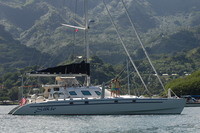
Who: Susan and John Fisher
Port: Oriental, North Carolina
Current Position
Favorite Links
No Links Added Yet
